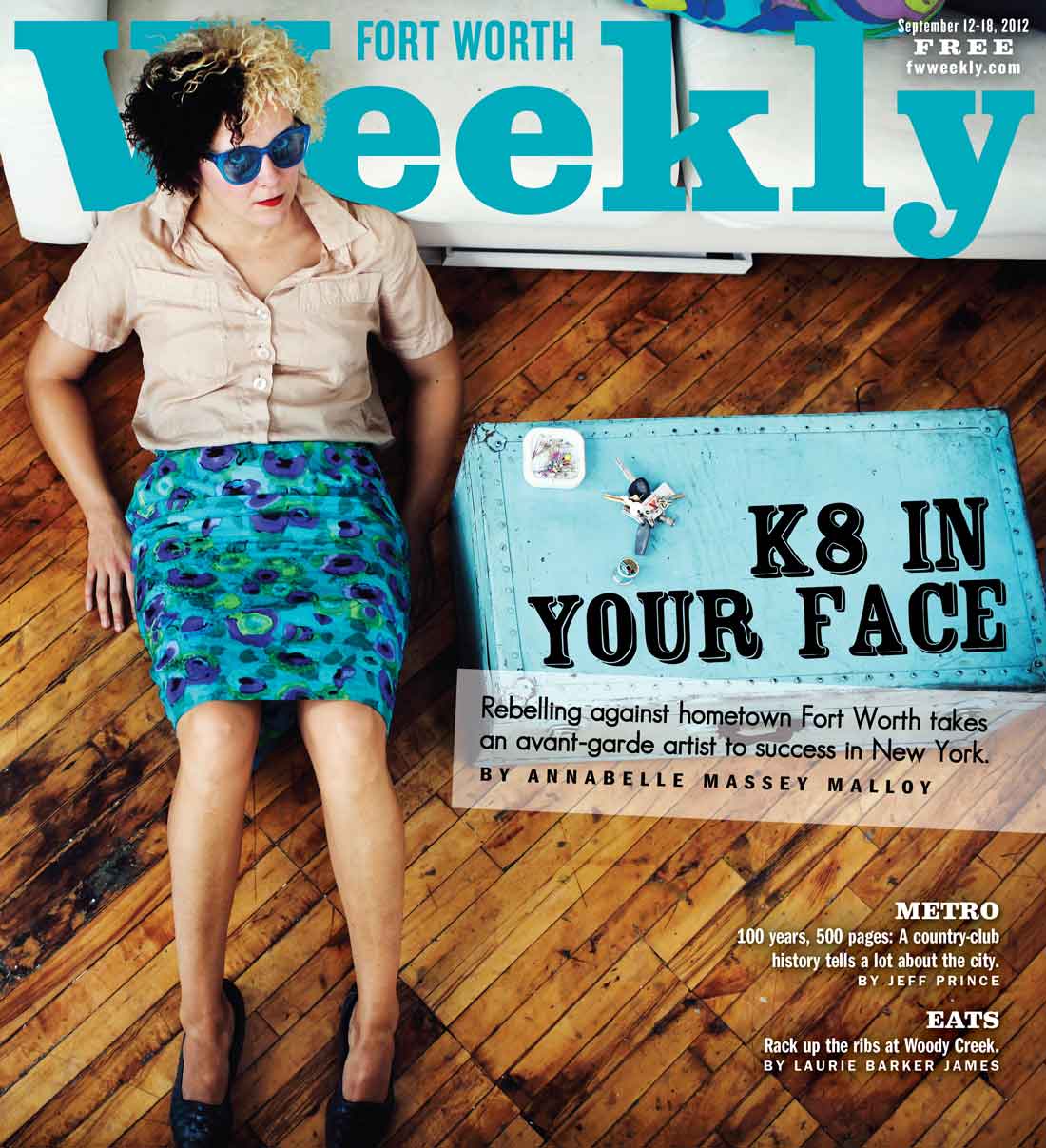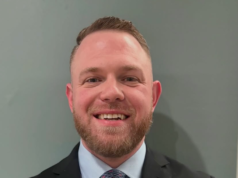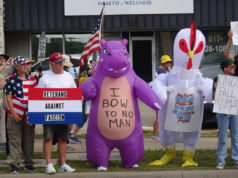For nine days in mid-July, K8 Hardy was marooned. On an island. She made the best of it, taking long walks on the deserted shore, sandwiched between wind-carved sand dunes on her left and the great blue Atlantic Ocean on her right. A castaway by choice, Hardy reveled in the vistas and the silence — no cell phone service, no internet, no cars. “It was glorious,” Hardy said. “A good creative time.”
She didn’t have to make fire, but she did have to make art. Hardy’s brief isolation took place on Fire Island, N.Y., in a hamlet known as “The Pines.” For two weekends and the week in between, she had a chance to make art uninterrupted — to recharge her imagination. She was a guest artist-in-residence of BOFFO, a nonprofit arts organization based in New York City.
Hardy, who prefers the alphanumeric K8 (pronounced “Kate”), is explaining that the late legendary fashion designer Halston (Roy Halston Frowick) was a frequent guest at The Pines. She wondered aloud if he had walked along this very stretch of beach. “I know he summered there often. Up there, they say ‘summered,’ ” she said, laughing at the quaint, East Coast, blue-blood expression. Apparently, she’s not from around there.Fire
Katherine Stevenson Hardy was born 3,000 miles from Fire Island — in conservative, traditional Fort Worth in 1977. Now she lives in New York City — one of the world’s fashion centers and, ahem, the cultural center of the known universe as far as art is concerned. Hardy’s art is gaining widespread recognition in the city and in art venues and museums in Europe. Her work scrambles the traditional ideas and imagery of women’s fashion — the standards of female beauty devised by pop culture, and women’s roles as reflected in various mainstream media.
She relates to Halston in that, in very different ways, they have fashion in common. And both of them were comfortable here on Fire Island, in a place that as early as 1960 had become a mecca for the gay community.
“It felt like a place where I was wanted, even with my eccentricities, and appreciated,” she said. “It was an important place in the early struggles of gay liberation. There is no place there for shame.”
Fire Island is a resort spot known for privacy, anonymity, and boisterous fun. It was also a punch line for late-night television hosts and stand-up comedians back in the ’60s, before gay men and women could be acknowledged openly in polite American society.
Hardy doesn’t mention “shame” in the context of her childhood and teenage years in Fort Worth. She speaks in terms of being “different” and “rebellious” and of her fascination with the media and pop culture that originated outside her hometown. “I was completely unaware of designer clothes until I moved to New York City,” she said.
Humor is a go-to emotion for Hardy. She is witty and well spoken and laughs easily. She looks like a pixie — 34, short bleached-blond hair, slight and athletic, with the gender fluidity that classic musical star Mary Martin achieved when she dressed up as Peter Pan on stage and screen. Hardy changes her hair as often as most people change their socks. She’s a chameleon, choosing outfits from a vast collection of thrift-store hand-me-downs, whether she’s turning herself into a model for self-portraiture or just getting dressed for the day.
One of Hardy’s tattoos shows in a photograph in which she wears a sleeveless shirt. The outline of the state of Texas is inked on her left bicep. While Fort Worth is very far away from where she lives and works now, she says it’s still the place she calls home. “Most of my family is there, and some good friends still. I get back when I can.”
It’s a bit more than an hour’s train ride from Fire Island to her small-ish apartment in a co-op building in Chinatown where she lives with her partner, Pati Hertling. Born in Berlin, Hertling is an attorney whose primary legal work involves the restitution of art to family members of Holocaust victims.
A New Yorker for 13 years, Hardy recently moved her studio to Bushwick in the north part of Brooklyn, closer to a tight-knit community of artists working toward — and waiting for — their big breaks. Hardy is already very successful as a performance artist, photographer, and experimental filmmaker. She’s an activist: Occupy-ing Wall Street, protesting the imprisonment of the members of the Russian punk band Pussy Riot, and co-founding Lesbians to the Rescue (LTTR), a gay feminist art collective that supports artist members by staging and promoting collaborative exhibits. She’s also a founding member of Working Artists and the Greater Economy (WAGE), an activist/advocacy group working to make sure that nonprofits pay artists fairly.
Hardy doesn’t garner the paparazzi or command the celebrity status — yet — of someone like Halston. His spirit (he died of AIDS in 1990) may still haunt Fire Island, but he became infamous for adorning NYC’s Studio 54, arm in arm with singer/actress Liza Minnelli or pop artist Andy Warhol. Halston adored women, working to create beauty on dress forms that would ultimately become couture clothing worn by the world’s elite. Hardy is also becoming well known in art circles, but her take on the fashion industry — and on women — is subversive. She destabilizes fashion, image, and identity. She’s irreverent and amusing. There’s an undercurrent of “Made you look!” in her creations. Often, she makes you look twice.
“I’m a feminist,” Hardy said. “I think about the way women are represented in culture, and I want to twist that. I offer a different perspective on the images of women that we’ve all grown so used to.”
Hers is the sensibility of a visual artist, a performer, and a rebel, re-examining accepted norms of beauty. She flaunts a feminist point of view and fights against the objectification of women’s bodies. She taunts the haute couture world, crafting outfits from thrift-store and vintage clothes and found objects. She brings a punk vibe to all of her art, tackling traditional images of women in high-fashion print ads, rocking the runway in performance pieces that mimic New York Fashion Week even as they mock the conventional fashion show.
Most recently, Hardy’s artful photography and sculpture were selected for exhibit in the prestigious Whitney Museum of American Art’s Biennial, held from March to May this year. The Whitney exhibit is by invitation only, an important snapshot of American art at large. Sometimes the show is laden with the art world’s heavy hitters, but more often its jurors — the curatorial types who seek out the best and most interesting in contemporary art — present newer artists whose creations are innovative or unique. In addition to her static work, the Whitney featured one of Hardy’s performance pieces. She produced, directed, and styled “Untitled Runway Show,” with Hardy-designed outfits and a radical vibe. On May 20, as punk rock music blasted and costumed models stomped down a white runway, Whitney visitors alternately gasped, giggled, and applauded the riotous event.
In July, as soon as she wrapped up the BOFFO project on Fire Island, Hardy returned to her studio to complete a multi-faceted body of new work, commissioned by the Dallas Contemporary. She’ll premiere the one-of-a-kind exhibit on Sept. 22, then present a runway show fund-raising event. It will be her first big solo exhibit in Texas.
How does she expect her aggressive aesthetic to play to hometown audiences? “I’m sure they can handle it,” she said thoughtfully. “There’s something about Texas. People have a very independent streak. You can be whomever you want. It’s risky, but I can’t be any other way.”
********













Love Annabelle’s reporting – this one is a jewel! (Imagine nice fist pump in the air). Woot!
Way to go DC, bringing overhyped institutionalloized rebellion to Dallas – once again 10-15 years late. Hope there is shiny stuff for the Dallasites to buy. Wuv de Ghost Sissie Spacek!